|
This species has been introduced into California. It is not a native species.
|
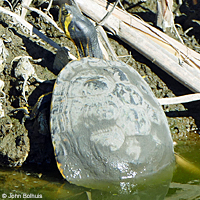 |
 |
|
|
| Adult, San Mateo County © John Bolhuis |
|
|
| |
|
|
|
| Yellow-bellied Sliders From Their Native Range |
 |
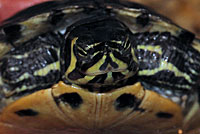 |
 |
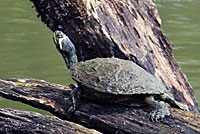 |
| Captive adult, Pitt County, North Carolina |
Adult, Pitt County, North Carolina |
 |
 |
|
|
Captive adult, Pitt County, North Carolina,
showing the yellow belly, with scattered dark markings. |
|
|
| |
|
|
|
| Comparison With Red-eared Slider |
 |
 |
 |
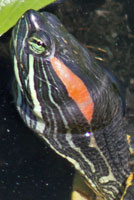 |
Yellow-bellied Slider
Broad yellow marking behind the eye - described as "S-shaped." |
Red-eared Slider
The Red-eared Slider has a characteristic red stripe behind eye,
which gives it the name "Red-eared." The red stripe is not always prominent.
Sometimes it is very thin or pale red or pink, and sometimes it is missing. |
| |
|
|
|
| Native Habitat |
 |
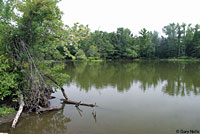 |
|
|
| Habitat, Pitt County, North Carolina |
Habitat, Pitt County, North Carolina |
|
|
|
|
|
|
| Description |
| |
| Size |
Typical adult males are 5-9 inches long (13-23 cm). Females are larger, typicallyn 8-13 inches long (20-33 cm). (Wickipedia)
|
| Appearance |
A medium to large freshwater turtle.
|
| Color and Pattern |
The carapace is black and brown often with yellow stripes.
Skin is olive green with patches of yellow on the legs and neck.
The backs of the hind limbs are marked with vertical yellow stripes and the front of the forlimbs are marked with narrow yellow stripes.
The name is derived from the yellow plastron (underside) which has round dark markings on the edges.
Adults tend to grow darker in color as they get older..
|
| Life History and Behavior |
Activity |
Diurnal
Semi-aquatic, spending much time in bodies of water, but
also travels overland during dry seasons to locate a new water source and during the breeding season to find mates. Females also move overland to find a site to lay eggs.
Tolerant of fairly dirty and even brackish water.
Feeds mostly in the morning before basking on logs, shorelines, or while floating.
Sleeps at night on the water bottom or on the surface near surface vegetation to hide under such as brush piles or mats of algae.
Basks out of the water on banks, rocks, logs, or other exposed objects, often in large groups, and sometimes stacked one upon another.
Brumation (T. scripta)
Sliders are able to survive moderate winters.
In native range, does not hibernate but becomes dormant during the cold of winter when it brumates.
Can remain active throughout the year in warmer areas on sunny winter days.
During cold winters, overwinters at the bottom of a pond or lake, remaining motionless, not eating or defecating, and breathing less frequently.
Can survive for weeks without taking in oxygen.
|
| Turtles Walking on Land Do Not Always Need to be Picked Up and Rescued |
| Turtles sometimes leave the water to search for food, a better place to live, a mate, or to lay their eggs in the spring - typically from March to June. If you see a turtle walking on the land, it is probably not sick or lost, so the best thing you can do for the turtle is to leave it alone. Some people want to help a turtle they think is in danger by picking it up and bringing it home or to a wildlife rehabilitation center, but most of the time this harms the turtle by removing it from the wild without reason. Sometimes turtles do get lost or stranded in yards or on busy roads or somewhere where they may be in danger. If you find one in such a situation, it's ok to move it out of danger, but it's best to leave it in a safe place as close to where you found it as possible. |
| Longevity |
| Captives can live to be more than 30 years old in the wild, and more than 40 years in captivity. |
| Predators |
| In the native range, predators include raccoons, foxes, skunks, opossums and alligators. Large wading birds will also prey on hatchling juveniles. |
| Diet and Feeding |
Omnivorous, eating leaves, roots, fruits, and stems of aquatic plants, aquatic invertebrates, snails, insects, crustaceans, mollusks, and vertebrates including fish, frogs, and tadpoles.
Hatchlings are primarily carnivorous, but consume progressively larger amounts of vegetation as they mature.
As they grow older, adults eat less meat, with most of their diet consisting of plants.
|
| Reproduction |
In the native range, adults mate in the water during spring, summer, and fall.
During courtship, males chase females, bit them, and display their long foreclaws.
Females move over land to dig a nest and lay 6-10 eggs or more, which
incubate for 2-3 months.
Hatchlings usually stay at the next through winter.
Interbreeds with Red-eared Sliders which can cause difficulties in identification.
|
| Habitat |
Found in a wide variety of habitats in its native range, mostly in calm fresh water areas with abundant aquatic vegetation, such as sluggish rivers, ponds, shallow streams, marshes, lakes, and reservoirs. Also been known to tolerate the brackish waters and survive in coastal waterways.
Found in similar habitat in California, mostly in areas with heavily-populated areas.
|
| Geographical Range |
Yellow-bellied Sliders occur naturally along the southeast coast of the U.S. in Virginia, the Carolinas, Georgia, the Florida Panhandle and extreme southern Alabama.
|
Yellow-bellied Sliders have been observed in many locations in California, mostly in the more populous regions in coastal southern California, and in the San Francisco Bay and Sacramento areas, but it is not known if they are established everywhere they've been found. It's likely that many sightings of them represent single released pets. Since they are not as numerous as the related Red-eared Sliders, they most likely interbreed with them, so some of the individuals observed may be a mixture of both subspecies.
|
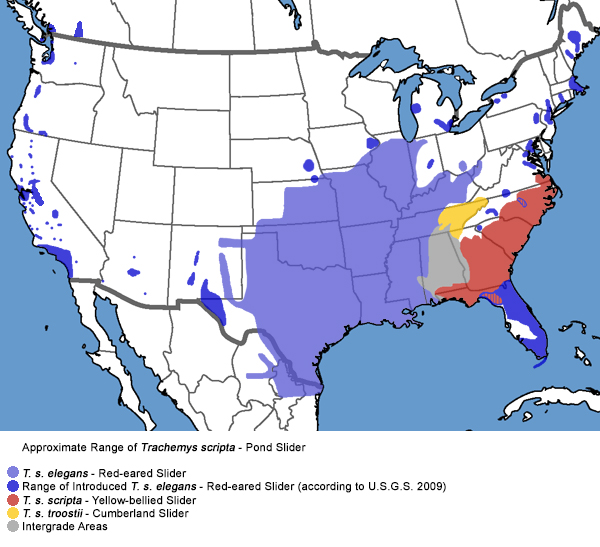 |
| Notes on Taxonomy |
Three subspecies of Trachyemys scripta occur in the United States. Several more occur to the south.
------------------------------------------------------------------------------------------------------------------------------------------------------------------------------------------------------------------------------
Trachemys Agassiz, 1857—Sliders
"Fritz et al. (2024, Vertebrate Zoology 74: 435-452) examined all continental Trachemys taxa except for Trachemys hartwegi (extralimital) using mitochondrial and nuclear DNA sequences and found that Trachemys represents a well-supported monophyletic group."
(Nicholson, K. E. (ed.). 2025 SSAR Scientific and Standard English Names List)
------------------------------------------------------------------------------------------------------------------------------------------------------------------------------------------------------------------------------
T. scripta (Thunberg in Schoepff, 1792)—Pond Slider
"Hedges et al. (2019, Caribbean Herpetology (67): 1-53) used the English name "Pondslider". We have followed the traditional English name usage of Turtle Taxonomy Working Group (2021, Chelonian Research Monographs (8): 1–472)."
(Nicholson, K. E. (ed.). 2025 SSAR Scientific and Standard English Names List)
------------------------------------------------------------------------------------------------------------------------------------------------------------------------------------------------------------------------------
"This subspeciers represents a tiny fraction of T. scripta sightings in CA, and pure examples are likely recent pet releases rather than hatched in the wild. There are too few T. s. scripta to find mates of the same subspecies, so they invariably breed with the much more abundant T. s. elegans, resulting in offspring with intermediate markings." (Hansen & Shedd, 2025)
Alternate and Previous Names (Synonyms)
Yellowbelly Turtle
Yellowbelly Slider
Testudo scripta Schoepff, 1792
Testudo serrata Daudin, 1801
Emys scripta Schweigger, 1812
Emys serrata Schweigger, 1812
Emys vittata Gray, 1831
Terrapene serrata Bonaparte, 1831
Clemmys (Clemmys) serrata Fitzinger, 1835
Pseudemys serrata Gray, 1856
Trachemys scripta Gray, 1863
Chrysemys scripta Boulenger, 1889
Pseudemys scripta Jordan, 1899
Chrysemys [scripta] scripta Siebenrock, 1909
Chrysemys palustris scripta Lindholm, 1929
Pseudemys scripta scripta Carr, 1937
Chrysemys scripts scripts Zappalorti, 1976 (ex errore)
Pseudermys scripa Nutaphand, 1979 (ex errore)
Trachemys scripta scripta Iverson, 1985
|
| Conservation Issues (Conservation Status) |
Like the widely invasive Red-eared Sliders, Yellow-bellied Sliders are popular in the pet trade, but few live to adulthood in captivity. Those that do are often released by owners who cannot provide a large enough enclosure for them or can't satisfy their other needs or who did not know that they can live more than 20 years in captivity and get tired of keeping them. Sliders have become established around the world where they have become an invasive species that is more aggressive than native turtle species and outcompetes them, causing conservation concerns.
|
|
|
Taxonomy |
| Family |
Emydidae |
Box and Water or Pond Turtles |
Gray, 1825 |
| Genus |
Trachemys |
Sliders |
Agassiz, 1857 |
| Species |
scripta |
Pond Slider |
(Schoepff, 1792) |
Subspecies
|
scripta |
Yellow-bellied Slider |
(Schoepff, 1792) |
|
Original Description |
Trachemys scripta - (Schoepf, 1792) - Hist. Testud., Pts. 1-2, p. 16, pl. 3, figs. 4 and 5
from Original Description Citations for the Reptiles and Amphibians of North America © Ellin Beltz
|
|
Meaning of the Scientific Name |
Trachemys - Greek - trachys = rough + emys = turtle
scripta - Latin = written, marked
from Scientific and Common Names of the Reptiles and Amphibians of North America - Explained © Ellin Beltz
|
|
Related or Similar California Turtles |
T. s. elegans - Red-eared Slider
A. m. marmorata - Northern Pacific Pond Turtle
A. m. pallida - Southern Pacific Pond Turtle
C. p. bellii - Western Painted Turtle
|
|
More Information and References |
California Department of Fish and Wildlife
Wickipedia
The Reptile Database
iNaturalist
Hansen, Robert W. and Shedd, Jackson D. California Amphibians and Reptiles. (Princeton Field Guides.) Princeton University Press, 2025.
Nicholson, K. E. (ed.). 2025. Scientific and Standard English Names of Amphibians and Reptiles of North America North of Mexico, with Comments Regarding Confidence in Our Understanding. Ninth Edition. Society for the Study of Amphibians and Reptiles. [SSAR] 87pp.
Robert Powell, Roger Conant, and Joseph T. Collins. Peterson Field Guide to Reptiles and Amphibians of Eastern and Central North America. Fourth Edition. Houghton Mifflin Harcourt, 2016.
Powell, Robert., Joseph T. Collins, and Errol D. Hooper Jr. A Key to Amphibians and Reptiles of the Continental United States and Canada. The University Press of Kansas, 1998.
Carr, Archie. Handbook of Turtles: The Turtles of the United States, Canada, and Baja California. Cornell University Press, 1969.
Ernst, Carl H., Roger W. Barbour, & Jeffrey E. Lovich. Turtles of the United States and Canada. Smithsonian Institution 1994.
(2nd Edition published 2009)
|
|
|
The following conservation status listings for this animal are taken from the July 2025 State of California Special Animals List and the July 2025 Federally Listed Endangered and Threatened Animals of California list (unless indicated otherwise below.) Both lists are produced by multiple agencies every year, and sometimes more than once per year, so the conservation status listing information found below might not be from the most recent lists, but they don't change a great deal from year to year.. To make sure you are seeing the most recent listings, go to this California Department of Fish and Wildlife web page where you can search for and download both lists:
https://www.wildlife.ca.gov/Data/CNDDB/Plants-and-Animals.
A detailed explanation of the meaning of the status listing symbols can be found at the beginning of the two lists. For quick reference, I have included them on my Special Status Information page.
If no status is listed here, the animal is not included on either list. This most likely indicates that there are no serious conservation concerns for the animal. To find out more about an animal's status you can also go to the NatureServe and IUCN websites to check their rankings.
Check the current California Department of Fish and Wildlife sport fishing regulations to find out if this animal can be legally pursued and handled or collected with possession of a current fishing license. You can also look at the summary of the sport fishing regulations as they apply only to reptiles and amphibians that has been made for this website.
This animal is not included on the Special Animals List, which indicates that there are no significant conservation concerns for it in California.
|
| Organization |
Status Listing |
Notes |
| NatureServe Global Ranking |
|
|
| NatureServe State Ranking |
|
|
| U.S. Endangered Species Act (ESA) |
None |
|
| California Endangered Species Act (CESA) |
None |
|
| California Department of Fish and Wildlife |
None |
|
| Bureau of Land Management |
None |
|
| USDA Forest Service |
None |
|
| IUCN |
|
|
|
|

















